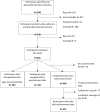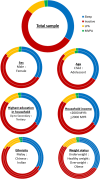Accelerometer-measured 24-hour movement behaviours over 7 days in Malaysian children and adolescents: A cross-sectional study
- PMID: 38377079
- PMCID: PMC10878504
- DOI: 10.1371/journal.pone.0297102
Accelerometer-measured 24-hour movement behaviours over 7 days in Malaysian children and adolescents: A cross-sectional study
Abstract
Background: Quantifying movement behaviours over 24-hours enables the combined effects of and inter-relations between sleep, sedentary time and physical activity (PA) to be understood. This is the first study describing 24-hour movement behaviours in school-aged children and adolescents in South-East Asia. Further aims were to investigate between-participant differences in movement behaviours by demographic characteristics and timing of data collection during Ramadan and COVID-19 restrictions.
Methods: Data came from the South-East Asia Community Observatory health surveillance cohort, 2021-2022. Children aged 7-18 years within selected households in Segamat, Malaysia wore an Axivity AX6 accelerometer on their wrist for 24 hours/day over 7 days, completed the PAQ-C questionnaire, and demographic information was obtained. Accelerometer data was processed using GGIR to determine time spent asleep, inactive, in light-intensity PA (LPA) and moderate-to-vigorous PA (MVPA). Differences in accelerometer-measured PA by demographic characteristics (sex, age, ethnicity, socioeconomic group) were explored using univariate linear regression. Differences between data collected during vs outside Ramadan or during vs after COVID-19 restrictions, were investigated through univariate and multiple linear regressions, adjusted for age, sex and ethnicity.
Results: The 491 participants providing accelerometer data spent 8.2 (95% confidence interval (CI) = 7.9-8.4) hours/day asleep, 12.4 (95% CI = 12.2-12.7) hours/day inactive, 2.8 (95% CI = 2.7-2.9) hours/day in LPA, and 33.0 (95% CI = 31.0-35.1) minutes/day in MVPA. Greater PA and less time inactive were observed in boys vs girls, children vs adolescents, Indian and Chinese vs Malay children and higher income vs lower income households. Data collection during Ramadan or during COVID-19 restrictions were not associated with MVPA engagement after adjustment for demographic characteristics.
Conclusions: Demographic characteristics remained the strongest correlates of accelerometer-measured 24-hour movement behaviours in Malaysian children and adolescents. Future studies should seek to understand why predominantly girls, adolescents and children from Malay ethnicities have particularly low movement behaviours within Malaysia.
Copyright: © 2024 Brady et al. This is an open access article distributed under the terms of the Creative Commons Attribution License, which permits unrestricted use, distribution, and reproduction in any medium, provided the original author and source are credited.
Conflict of interest statement
The authors have declared that no competing interests exist.
Figures




Similar articles
-
The cross-sectional and prospective associations of parental practices and environmental factors with 24-hour movement behaviours among school-aged Asian children.Int J Behav Nutr Phys Act. 2024 Mar 4;21(1):27. doi: 10.1186/s12966-024-01574-x. Int J Behav Nutr Phys Act. 2024. PMID: 38438945 Free PMC article.
-
Association between sociodemographic, dietary, and substance use factors and accelerometer-measured 24-hour movement behaviours in Brazilian adolescents.Eur J Pediatr. 2021 Nov;180(11):3297-3305. doi: 10.1007/s00431-021-04112-0. Epub 2021 May 15. Eur J Pediatr. 2021. PMID: 33993399
-
Resemblance in accelerometer-assessed physical activity in families with children: the Lolland-Falster Health Study.Int J Behav Nutr Phys Act. 2020 Dec 4;17(1):161. doi: 10.1186/s12966-020-01067-7. Int J Behav Nutr Phys Act. 2020. PMID: 33276796 Free PMC article.
-
Associations Between Parent Self-Reported and Accelerometer-Measured Physical Activity and Sedentary Time in Children: Ecological Momentary Assessment Study.JMIR Mhealth Uhealth. 2020 May 19;8(5):e15458. doi: 10.2196/15458. JMIR Mhealth Uhealth. 2020. PMID: 32348283 Free PMC article.
-
Accelerometer-measured physical activity and sedentary behavior in Chinese children and adolescents: a systematic review and meta-analysis.Public Health. 2020 Sep;186:71-77. doi: 10.1016/j.puhe.2020.07.001. Epub 2020 Aug 9. Public Health. 2020. PMID: 32784098
Cited by
-
Assessment of Perceived Physical Literacy and Its Relationship with 24-Hour Movement Guidelines in Adolescents: The ENERGYCO Study.Int J Environ Res Public Health. 2025 Jan 29;22(2):194. doi: 10.3390/ijerph22020194. Int J Environ Res Public Health. 2025. PMID: 40003421 Free PMC article.
References
-
- Verloigne M, Van Lippevelde W, Maes L, Yıldırım M, Chinapaw M, Manios Y, et al.. Levels of physical activity and sedentary time among 10- to 12-year-old boys and girls across 5 European countries using accelerometers: an observational study within the ENERGY-project. International Journal of Behavioral Nutrition and Physical Activity. 2012;9(1):34. doi: 10.1186/1479-5868-9-34 - DOI - PMC - PubMed
-
- Ekelund U, Sardinha LB, Anderssen SA, Harro M, Franks PW, Brage S, et al.. Associations between objectively assessed physical activity and indicators of body fatness in 9- to 10-y-old European children: a population-based study from 4 distinct regions in Europe (the European Youth Heart Study). Am J Clin Nutr. 2004;80(3):584–90. doi: 10.1093/ajcn/80.3.584 . - DOI - PubMed
MeSH terms
Grants and funding
LinkOut - more resources
Full Text Sources
Medical
Miscellaneous

